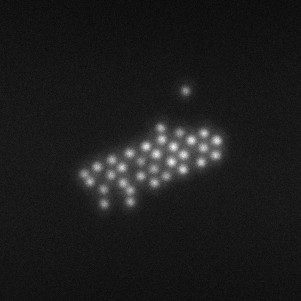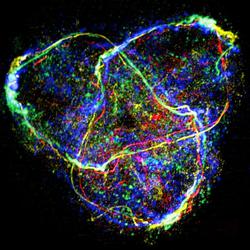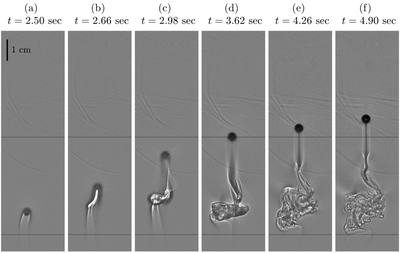 300 nm particles in an optically bound array. We are currently exploring methods to alter the optical binding force to produce more complicated structures.
300 nm particles in an optically bound array. We are currently exploring methods to alter the optical binding force to produce more complicated structures.
How does the composite structure of a collection of particles depend on their interactions? Can we control these interactions to make a desired structure on demand? These are the central questions of the field of self-assembly, a subject of interests for scientists including chemists, biologists, engineers, and physicists. Colloidal systems — collections of nanometer to micron diameter particles in a fluid — are a particularly convenient model system for exploring these questions. Colloidal particles are big enough to image directly with a microscope, but small enough that they are thermally excited. There are many methods for creating forces between colloids, but they are typically short range and time-consuming to alter.
An alternative to these conventional approaches is optical-binding, a relative of optical trapping where an intense laser is used to create a force between indvidual particles. This interparticle force is highly tunable, depending on laser wavelength, polarization, direction of propagation, etc. This provides a unique experimental playground for understanding the relationship between interparticle forces and resulting structure.
Preliminary results from our group indicate that interesting structure modifications are possible via relatively simple modifications of the light propagation direction. It also appears that many body and non-conservative forces play an important role in the optical binding forces of large and/or high contrast particles. This means optical binding can also be used to explore the dynamics of active particles, and we are in the early stages of exploring when and how these effects arise.
In collaboration with the Burton Lab (Emory)
Optical binding forces arise because of optical interference effects — an analogous force should also be present for acoustic fields. In principle, this could also be used to control the mm-scale structure of acoustically levitated particles, but this effect has remained almost entirely unexplored.
We are currently constructing a holographic acoustic levitation apparatus to demonstrate the existence of this effect. If successful, this should allow us to experiment with the same concepts as optical binding, but in an athermal, easily accesible regime.
 An overlay of vortex knots at different scales, imaged with micro-bubbles.
See “Creation and dynamics of knotted vortices,” Nature Physics (2013).
An overlay of vortex knots at different scales, imaged with micro-bubbles.
See “Creation and dynamics of knotted vortices,” Nature Physics (2013).
Any incompressible fluid flow can essentially be thought of as a collection of vortex lines. This is most strikingly illustrated by a smoke ring, which is an extended flow field whose dynamics can be described simply in terms of the compact toroidal core. In the case of complex flows like turbulence, these vortex lines can become quite tangled, and their subsequent behavior can be very complicated. In fact, many open questions remain about the dynamics of very simple vortex tangles, like elementary knots or links. Prior to starting his position at UCM, the PI developed the first techniques to create isolated vortex knots in experiments. Furthermore, we were able to measure their detailed dynamics using a novel high-speed 3D imaging apparatus. These results indicated that vortex knots are in fact actively unstable, in direct contrast to theoretical arguments that they should be long-lived structures in a flow.
Currently, we are working to develop simplified models to explain the dynamics of these knotted structures. We are also developing experiments to study other fluid flows which are dominated by compact vortical structures, such as the transition to turbulence and flapping wing flight. By focusing on the structure of vortices as the organizing element of a flow, this offers a unique perspective on many questions in fluid dynamics.
In colloboration with the Khatri and Theillard Group (Applied Math at UCM)
 Shadowgraph images of a droplet passing through a stratified interface, showing the entrained fluid.
Adapted from ArXiv:1908.04440.
Shadowgraph images of a droplet passing through a stratified interface, showing the entrained fluid.
Adapted from ArXiv:1908.04440.
When oil spills in the ocean it produces a plume of tiny oil droplets suspended in the surrounding salt water. Because the oil is less dense than the water, one would expect the droplets to simply rise to the surface. In practice, however, it is often observed that the droplets become trapped for long periods of time at specific layers in the ocean where the density is changing relatively rapidly, due to variations in temperate or salinity. This effect is caused denser ocean layers being entrained with the droplets as they rise, making them effectively heavier. Additionally, surface tension and many body effects seem to be important, although these have not been studied in detail to date. Thus, despite the fact that this is an important practical problem for oceanography, it remains poorly understood due to the surprisingly complex fluid mechanics involved.
We are currently developing a combined numerical and experimental study of this problem in collaboration with several professors in Applied Math. Due to the complexity of the problem, the research effort will include multiple stages, beginning with simple experiments and fully resolved numerical simulations to understand the behaviors of single or small numbers of droplets. The next stage — currently in development — will incorporate the 3D scanning apparatus developed for vortex experiments (described above) to reconstruct the droplet structure and density gradients of a complex oil plume. We are also developing simplified numerical models which should allow us to understand the complex interplay of many droplets and how this scales to the dynamics relevant for real ocean conditions.
It is well known that the speed of light decreases when it enters a medium like glass or water. Surprisingly, however, there is a long standing debate about what happens to the momentum of light: does it increase or decrease? Although many scientists have tackled this question over the years from both a theoretical and experiment approach, a clear answer has not emerged (Abraham–Minkowski controversy). This is largely due to the fact that absolute amount of momentum carried by a beam of light is quite small, and so it is difficult to measure and isolate from spurious effects.
We are currently developing a novel approach to measure the momentum of light by using a modulated laser to create (very small) waves on the surface of a pool of water.
